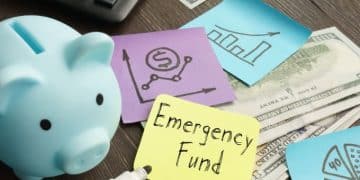Complete guide to personal finance: From budgeting to investing

If you’re looking to transform your financial life in the United States, this complete guide to personal finance is for you.
Throughout this content, you’ll learn how to build an effective budget, manage income and expenses, set financial goals, build an emergency fund, make conscious investments, and separate personal and business finances.
With practical tips, official links, and real-life examples, this guide will help you achieve financial stability and long-term success. Keep reading and take the first step towards your financial freedom.
Personal finance forms the foundation of any life plan, whether short- or long-term. In a fast-paced consumer culture where credit is easily available and online shopping is just a click away, financial discipline is essential.
More than just knowing how much you earn and spend, effective money management reduces stress, prevents debt, and helps you achieve your dreams with greater organization and peace of mind.
Creating an effective budget
The first step toward financial stability is building a monthly budget. This helps you understand your spending habits, control your expenses, and plan for future goals.
How to create a budget step-by-step
Start by listing all sources of income, such as your salary, side gigs, and investment earnings.
Then, write down fixed expenses (like rent, utilities, and insurance) and variable expenses (such as groceries, entertainment, and gas).
A good rule of thumb is the 50/30/20 method: 50% for needs, 30% for wants, and 20% for savings and debt payments. This method is simple, flexible, and effective for most U.S. households.
Top budgeting apps in the U.S.
Use apps like Mint by Intuit, which connects to your bank accounts and tracks spending in real time, You Need a Budget (YNAB), which helps allocate every dollar, and Personal Capital, which is ideal for both budgeting and investment tracking.
How to stay disciplined with your budget
Review your budget weekly, automate savings transfers, and set realistic goals. Keep a list of financial priorities and avoid impulse purchases.
Use apps that send alerts when you exceed category limits. Financial discipline comes from routine and awareness.
Managing income and expenses
It’s not enough to plan a budget — you must track what’s actually happening. Income and expense management is key to maintaining a balanced financial life.
How to categorize your spending
Categorize your expenses: housing, transportation, groceries, health care, subscriptions, and entertainment.
Use spreadsheets or apps like Mint to keep everything organized. Consistency is crucial to uncovering spending patterns and identifying areas for improvement.
Balancing income and spending
Set monthly spending limits by category. Refinance high-interest debts, reduce utility bills, and avoid lifestyle inflation.
Increase your income with freelancing or side gigs via platforms like Upwork or Fiverr. Automate bill payments to prevent late fees.
Cutting unnecessary expenses
Review bank and credit card statements regularly. Cancel unused subscriptions on services like Rocket Money.
Use the 24-hour rule before making non-essential purchases. Focus on needs over wants, and redirect those small savings into your emergency fund.

Setting financial goals
Clear financial goals give purpose to your planning. Whether you want to pay off debt, save for a home, or retire early, setting realistic goals helps you stay on track and motivated.
How to set realistic financial goals
Use the SMART criteria: Specific, Measurable, Achievable, Relevant, and Time-bound. For example, instead of saying “I want to save money,” say “I want to save $6,000 in 12 months for a down payment on a car.”
Short, medium and long-term goals
Short-term (up to 1 year): build a $1,000 emergency fund, pay off a credit card. Medium-term (1–5 years): save for a wedding, home down payment, or college.
Long-term (5+ years): retirement planning through 401(k) or Roth IRA, or saving for a child’s education.
How to track and adjust your goals
Use tools like YNAB or Personal Capital to track progress. Reevaluate quarterly and adjust based on life changes. Stay flexible but committed to the big picture.
Building an emergency fund
An emergency fund protects you from unexpected events and forms the backbone of your financial security.
Why emergency funds are essential
Job loss, medical emergencies, car repairs — life happens. A solid emergency fund prevents you from relying on high-interest credit cards or payday loans. It’s your safety net.
How much to save and where to keep it
Aim for 3 to 6 months of essential expenses. Store it in a high-yield savings account like those from Ally Bank or Marcus by Goldman Sachs.
Avoid locking it in investments that you can’t access quickly.
How to build your emergency fund gradually
Set up an automatic monthly transfer to your emergency fund. Redirect tax refunds, bonuses, or side income. Use cashback from apps like Rakuten or Dosh to top it off.
Conscious investing
Investing is how you grow your wealth and achieve financial independence. But to invest wisely, you need a solid foundation and strategy.
Basic principles of investing
Understand your risk tolerance. Beginners should start with low-cost index funds or ETFs. Use platforms like Fidelity or Charles Schwab.
Educate yourself using trusted sources like Investopedia or this YouTube video: Investing for Beginners
Diversification and risk profile
Diversification protects your investments from market volatility. Spread your money across stocks, bonds, and real estate.
Conservative investors may favor bonds, while risk-takers prefer tech stocks or crypto.
Examples of investment types: pros and cons
| Investment Type | Pros | Cons |
|---|---|---|
| High-Yield Savings | Safe, liquid, FDIC-insured | Low returns, not ideal for long-term growth |
| Treasury Bonds | Backed by U.S. government, predictable returns | Returns may not beat inflation |
| Index Funds (ETFs) | Low fees, broad diversification | Subject to market volatility |
| Individual Stocks | High growth potential | High risk, requires research |
| Real Estate (REITs) | Monthly income, property exposure without ownership | Sensitive to market cycles, less liquid |
Separating personal and business finances
If you’re self-employed or a small business owner, separating personal and business finances is non-negotiable. It’s vital for legal, tax, and planning reasons.
https://www.youtube.com/watch?v=eycgbXyST50
Why it’s important to separate finances
Mixing accounts complicates tax filing, limits your ability to get business credit, and blurs the lines on actual profitability. The IRS recommends separating finances to ensure clear record keeping (source).
Strategies for keeping finances separate
Open a dedicated business current account through banks like Chase for Business or Bank of America. Set up a salary or owner’s draw. Use accounting software like QuickBooks to monitor everything.
Managing your personal finances in the United States requires consistency, education, and the right tools.

Start by building a solid budget, cutting unnecessary expenses, setting smart goals, and creating an emergency fund. Once you’re ready, explore diversified investments aligned with your profile and goals.
To stay informed, follow government resources like Consumer Financial Protection Bureau and Investor.gov. Bookmark our blog for more guides and tools to master your financial future.





